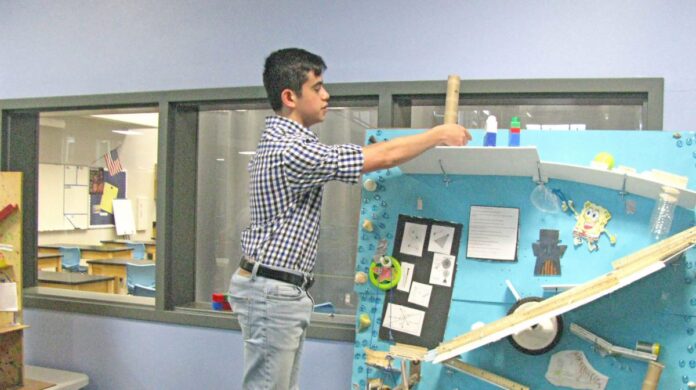HARLINGEN — It’s the law.
Actually, they are Newton’s 3 Laws of Motion, and the marbles obeyed as they rolled loudly down the tubes.
“Crack, crack, rattle, ping, gong,” they seemed to sing as they rolled down small planks.
Like children complying with their teacher, the marbles obeyed the law that an object remains in motion at the same speed and in the same direction unless acted upon by an unbalanced force.
Montrell Johnson and his classmates at the Harlingen School of Health Professions watched with satisfaction as the marbles ran their course, setting off a series of events.
Their’s was one of five projects created by students in Aaron Chila’s Advanced Placement Physics class.
The students used their projects to give demonstrations of how the laws of nature work. Chila was impressed with all the projects.
“It feels pretty good,” he said. “They did a lot of integration. The project was to apply different concepts, Newton’s 3 Laws of Motion, simple motors.”
The projects included references to cartoons drawn by Rube Goldberg, known for his illustrations of overly complicated machines to perform simple functions.
The student projects closely resembled Goldberg’s designs, using marbles, paper clips, glue, egg shells, yo-yos, wooden inclines and other materials.
The students used those materials to perform tasks using formulas for speed, force, velocity, kinetic energy, potential energy and numerous other laws of nature.
“We tried to put different machines into our project,” said Montrell, 15, a sophomore.
In this sense, “machines” refers to levers, wheels, axles, pulleys and other simple devices.
Each project had a different theme, such as a Christmas theme, an artist’s theme and an underwater theme.
Marco Martinez’s group took a novel approach with a blue underwater theme. Marco, 15, stood and placed a golf ball at the top. It rolled down one incline, then another, funneled by rulers on each side. Its little trip set off a series of reactions which resulted in fish food being dropped in a glass bowl.
The project created by Montrell and his classmates caused vinegar to drip down an inclined plane to a jar of baking soda. The chemical reaction created a gas which inflated a plastic glove.
“We just made a chemical reaction and a physical reaction,” said Morgan Johnson, 16, who was demonstrating the project she’d worked on with Montrell and two others.
Hunter Gayther and his classmates made numerous changes to their project over a two-week period.
“We wanted to figure in all types of motion,” said Hunter, 16. “The third law of motion, the ball goes down the tube. It was a lot of improvising. We had to come up with different ways to make it work. It turned out really well. This is both kinetic and potential energy.”




